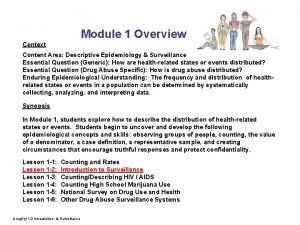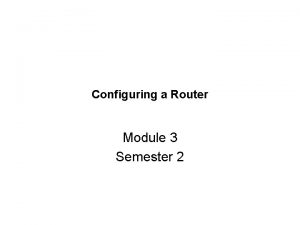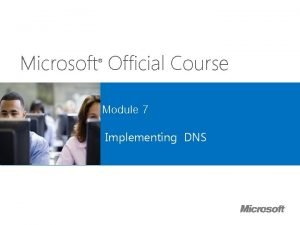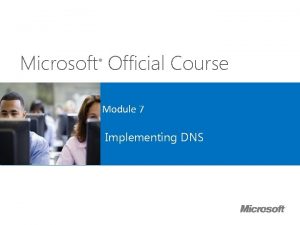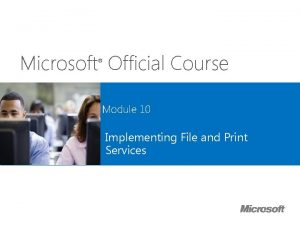Microsoft Official Course Module 7 Planning and Implementing































- Slides: 31

Microsoft Official Course ® Module 7 Planning and Implementing Disaster Recovery

Module Overview • Planning for Disaster Mitigation • Planning and Implementing Exchange Server 2013 Backup • Planning and Implementing Exchange Server 2013 Recovery

Lesson 1: Planning for Disaster Mitigation • Identifying Data-Loss Scenarios • Data-Loss Mitigation Features • Planning a Disaster Mitigation Strategy • Discussion: What Is the Relationship Between Disaster Recovery and High Availability? • Exchange Server Native Data Protection • Discussion: When Is Exchange Server Native Data Protection Appropriate? • What Are the Timelines for Disaster Recovery? • Scenarios Requiring Backup and Restore

Identifying Data-Loss Scenarios Data loss scenarios Lost item • Lost mailbox • Lost database • Lost server •

Data-Loss Mitigation Features • Mitigating data loss avoids the need to recover from backup • Data-loss mitigation features include: Deleted item recovery • Single item recovery • In-place hold • Deleted mailbox retention • DAGs • Shadow redundancy •

Planning a Disaster Mitigation Strategy Considerations include: Increase Deleted Item Retention increases database size • Increase Deleted Mailbox Retention increases database size • DAGs may prevent service outages due to lost databases and lost servers • Replay lag time may prevent data corruption on a passive copy in a DAG •

Discussion: What Is the Relationship Between Disaster Recovery and High Availability? • What high-availability features can be used as a first line against a disaster? • What do you achieve if you are using fault- tolerant hardware?

Exchange Server Native Data Protection Exchange Native Data Protection includes the following Exchange Server 2013 features: High availability that minimizes downtime and data loss • Single-item recovery and In-Place hold policies for recovering deleted messages • Point-in-time database recovery with lagged copies of mailbox databases • Archive mailboxes, retention and archive policies, In-place e. Discovery for managing large mailboxes • Exchange Native Data Protection reduces costs by: Simplifying management • Requiring no backup software or hardware • Requiring no RAID •

Discussion: When Is Exchange Server Native Data Protection Appropriate? • Does your organization work with Exchange Server 2010 or 2013 and that uses only Exchange Server Native Data Protection? Why? • Does your organization use traditional backups? Why? • Does your organization use combination of Exchange Server Native Data Protection and traditional backups? Why? • Which features of Exchange Server Native Data Protection do you use in your organization? • In which situation is it appropriate to use only Exchange Server Native Data Protection?

What Are the Timelines for Disaster Recovery? The RTO determines: • How quickly the service is restored The RPO determines: • From what point in time is the disaster recovery performed Based on the RTO and RPO, you might choose to: Keep databases small to shorten restore times • Keep transaction logs on separate drives to ensure they can be replayed after a restore • Backup up every few hours to ensure minimal data is lost •

Scenarios Requiring Backup and Restore Scenarios: Recover a message when single-item recovery is not enabled • Recover a mailbox after the mailbox retention period has passed • Recover a public folder item after the item retention has passed • Recover from a failed database when a DAG is not in use • Recover from a failed server when a DAG is not in use • Backups may be used to meet compliance requirements

Lesson 2: Planning and Implementing Exchange Server 2013 Backup • Backup Requirements for Exchange 2013 • Choosing Exchange Server Backup Software • Choosing Exchange Server Backup Media • How Does a VSS Backup Work? • Demonstration: How to Back Up Exchange Server 2013

Backup Requirements for Exchange 2013 Exchange Server Role Backed-Up Data All roles • System State of server and Active Directory database on domain controllers • Databases and transaction logs • Message tracking logs • Unified Messaging custom audio prompts • Server certificates used for SSL • Specific Internet IIS configuration Mailbox server Client Access server

Choosing Exchange Server Backup Software Windows Server Backup: Runs locally on the computer running Exchange Server • Cannot back up to tape • Restore only full databases • Cannot backup passive DAG copies • DPM: Uses agents on the computer running Exchange Server • Typically backs up to disk and then archives to tape • Can restore databases or mailboxes • Can back up passive DAG copies • Non-Microsoft backup software may be able to: The backup software must support VSS • Restore individual items • Perform brick-level backups •

Choosing Exchange Server Backup Media Description Tape Disk SAN-based Is physically easy to transport and very durable Increases backup performance Backs up the traffic of the main network and keeps it on the SAN

How Does a VSS Backup Work? Exchange 2013 and VSS backup • The VSS writer inside Microsoft Exchange Information Store is moved to the Microsoft Exchange Replication service • Referred now as the Microsoft Exchange Writer • Used by Exchange-aware VSS-based applications to backup and restore active and passive database copies • For backup and restore, the Microsoft Exchange Information Store and the Microsoft Exchange Replication service are required and need to be running

Demonstration: How to Back Up Exchange Server 2013 In this demonstration, you will see how to: • Install the Windows Server Backup program • Use Windows Server Backup to back up Exchange 2013

Lesson 3: Planning and Implementing Exchange Server 2013 Recovery • Options for Recovering Exchange Server Functionality • Options for Recovering Mailbox Data and Databases • Planning the Recovery of Client Access Servers • Repairing Exchange Server Database Corruption • Process for Recovering Data Using the Recovery Database • Demonstration: How to Recover Data by Using the Recovery Database • What Is Dial-Tone Recovery? • Process for Implementing Dial-Tone Recovery

Options for Recovering Exchange Server Functionality To replace lost server roles: Build a new server with equivalent functionality • Add roles to an existing Exchange server • To restore a lost server: Build a new server • Restore system state (optional) • Install Exchange Server with Recovery mode • Restore any necessary data •

Options for Recovering Mailbox Data and Databases • When a database or server fails, you have several options for recovery, including: Options Database restore Recovery database Database portability Dial-tone recovery DAG recovery Description Replaces an existing database Restores database to an alternate location for data recovery Restores database without having to recover a specific server Restores server functionality rapidly before historical mailbox contents are restored Mounts a database copy on a different Exchange server with the mailbox role installed

Planning the Recovery of Mailbox Data and Databases Considerations: Use DAGs to avoid the need to recover • Separate transaction logs and databases • Use a dial-tone database to speed up recovery • Allocate disk space for a recovery database • Use mailbox databases with a smaller size •

Planning the Recovery of Client Access Servers • The basic functions of Client Access servers can be recovered without backup up existing servers • Replace a failed Client Access server by: Adding the server role to an existing Exchange server • Deploying a new server with the same server role • • Replacing and deploying a new server can result in some applications requiring reconfiguration

Repairing Exchange Server Database Corruption • The following cmdlet to repair database corruption is available: • New-Mailbox. Repair. Request • The cmdlet provides the following benefit over isinteg. exe: No need to take the database offline • Runs on Windows Power. Shell, enabling you to automate the process •

Process for Recovering Data Using the Recovery Database A recovery database allows you to: Restore the database from backup • Mount the database and extract data • Recovery database scenarios include: Dial-tone recovery • Individual mailbox recovery • Specific item recovery •

Demonstration: How to Recover Data by Using the Recovery Database In this demonstration, you will see how to: • Create the recovery database • Restore data to the recovery database • Create a new Mailbox. Restore. Request

What Is Dial-Tone Recovery? • Dial-tone recovery is the process of implementing access to email services without restoring data to user mailbox • Dial-tone recovery benefits: Enables users to send and receive email as soon as possible after the loss of a database or server • Dial-tone database can be merged with the recovered database into a single up-to-date mailbox database •

Process for Implementing Dial-Tone Recovery Process for implementing dial-tone recovery: 1. Create the dial-tone database 2. If necessary, configure the mailboxes that were on the database to use the new dial-tone database 3. Restore the database and log files that you want to recover into the Recovery Database 4. Swap the dial-tone database with the database that you have recovered in the step before 5. Export and import the content from the dial-tone database into the recovered original database

Lab: Implementing Disaster Recovery for Exchange Server 2013 • Exercise 1: Backing Up Exchange 2013 • Exercise 2: Restoring Exchange Server 2013 Data • Exercise 3: Exchange Server 2013 Disaster Recovery (Optional) Logon Information Virtual Machines User name Password 20341 B-LON-DC 1 20341 B-LON-CAS 1 20341 B-LON-MBX 1 AdatumAdministrator Pa$$w 0 rd Estimated Time: 75 minutes

Lab Scenario You are a messaging administrator for A. Datum Corporation. Your organization has deployed Exchange Server 2013. You now want to ensure that all Exchange server-related data is backed up and that you can restore not only the full server or database, but also a mailbox or mailbox folder.

Lab Review • Which feature do you need before you can run a local backup on an Exchange Server 2013 with the Mailbox role installed? • Which tool do you need to create a Recovery Database in Exchange Server 2013?

Module Review and Takeaways • Review Questions • Tools • Real-world Issues and Scenarios • Best Practice
 Microsoft official academic course microsoft word 2016
Microsoft official academic course microsoft word 2016 Microsoft official academic course microsoft excel 2016
Microsoft official academic course microsoft excel 2016 Microsoft official academic course microsoft word 2016
Microsoft official academic course microsoft word 2016 It academy microsoft
It academy microsoft Official compendia
Official compendia Planning and implementing crm projects
Planning and implementing crm projects Simple discourtesy in the course of official duties
Simple discourtesy in the course of official duties Course title and course number
Course title and course number C device module module 1
C device module module 1 Situational frontline leadership
Situational frontline leadership Course module sample
Course module sample Chapter 7 strategic management
Chapter 7 strategic management Strategy implementation example
Strategy implementation example Implementing strategies: management and operations issues
Implementing strategies: management and operations issues Setting prices and implementing revenue management
Setting prices and implementing revenue management Toyota brand hierarchy
Toyota brand hierarchy Designing and implementing brand architecture strategies
Designing and implementing brand architecture strategies Matching structure with strategy
Matching structure with strategy Toyota brand hierarchy
Toyota brand hierarchy Ch 7
Ch 7 Half brick wall in stretcher bond
Half brick wall in stretcher bond Chaine parallèle muscle
Chaine parallèle muscle Situational syllabus
Situational syllabus Microsoft wireless router module
Microsoft wireless router module Microsoft assessment and planning toolkit download
Microsoft assessment and planning toolkit download Cloudamize documentation
Cloudamize documentation Hrd program implementation
Hrd program implementation Retail management notes doc
Retail management notes doc Principle in portfolio assessment
Principle in portfolio assessment Qsen core competencies
Qsen core competencies Challenges of implementing predictive analytics
Challenges of implementing predictive analytics Implementing organizational change spector
Implementing organizational change spector










